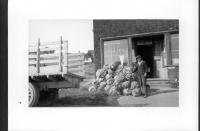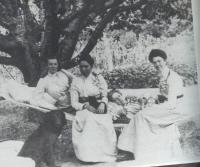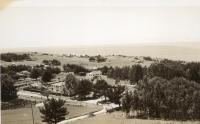The influenza pandemic struck the Coastside in September 1918. The killer flu had moved from the east to the west coast but strangekly the epidemic was not the lead story in the newspapers. Was it because World War I was still raging with young American soldiers dying in the trenches in Europe?
In the U.S. army bases– crowded with recruits waiting for orders to go off to war–were hard hit by the virus. In the big East Coast cities, the manufacture of coffins lagged far behind the number of bodies needing burial, according to Alfred Crosby’s book, mentioned in earlier posts.
Like wildfire, the virus cut a wide swath of devastation behind as it headed to the West Coast. At its peak some 30 cases were reported daily in San Mateo—fortunately, the deaths from this horrific flu never matched the numbers back East.
No matter, everyone was frightened of every sneeze, of every sniffle, of every cough. In San Francisco legislation required “every person appearing on the public streets to war a mask”. While protective masks were serious business, some in the fashion world made light of it, adding masks as an accessory to the latest fall wear for women.

The Coastside Comet’s Editor George E. Dunn. The Comet was located in Moss Beach and the building still stands on Hwy 1.
The Coastside Comet building later served as a U.S. post office, real estate and electric company office –and as the headquarters for local photographer R. Guy Smith–who had been the postmaster and real estate agent! What’s in all those bags?
–and as the headquarters for local photographer R. Guy Smith–who had been the postmaster and real estate agent! What’s in all those bags?
Following San Francisco’s lead, a similar “mask” resolution was passed by a special session of the San Mateo County Board of Supervisors. The penalty for being caught without a “muzzle” was a $100 fine and or ten days in jail.
Most everyone obeyed the law and wore pads of gauze tied in place with strings around the head. Mailmen and barbers and store clerks wore the mask. They were hot, scratchy and impractical.
One of Pescadero’s most controversial citizens, Loren Coburn, a grumpy landowner who was always at odds with the villagers, wore the mask but still fell ill and died at age 92. The flu also struck down Howard Frey, who at 24 apparently fit the more common profile of those who died.
More importantly, some believed the masks violated their personal liberties–and they made their voices heard.
That year Thanksgiving was a real thanksgiving as the epidemic began to pull back, with the bureaucrats who promoted mask wearing taking credit. But there were skeptics and Coastside Comet Editor George E. Dunn was one who questioned the efficadcy of the gauge masks. Dunn knew Coastsiders who had worn the mask and still succumbed to the flu.
The Coastside’s George E. Dunn knew San Francisco Board of Health Chief Dr. William Hassler– (who wore the “snort” version of the gauze mask, which observers said gave him a “pig-like” appearance–and the editor asked, “Answer this. Why is it that some folks who wore a muzzle on their mouths caught influenza and some folks who didn’t wear a muzzle didn’t catch influenza? Speak up!”
If there was an answer, it went unreported. (Dunn was later vindicated, as medical evidence indicated the mask offeredno significant protection).
By December the worst was over–and six days later this ad appeared in George Dunn’s Coastside Comet: “Two secondhand flu masks for sale, both in good order….”


